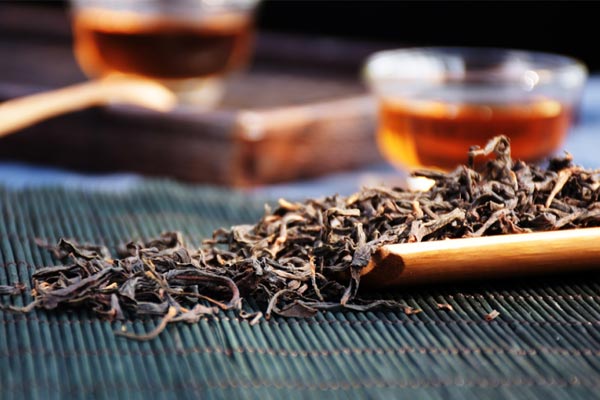Black tea is the most consumed tea worldwide, accounting for approximately 75% of total tea consumption.
According to relevant statistics, in China, mid-quality black tea, priced around 180 yuan per kilogram (500 grams), accounts for the largest share of consumption.
Recently, a research team from Hunan Agricultural University published a research paper titled "Reveal the differences in flavor of five varieties of black tea via sensory evaluation, UPLC, and GC x GC-OTOFMS approaches" in the journal Food Chemistry: X. The paper reveals the flavor secrets of Zunyi, Keemun, Lapsang Souchong, Fengqing Dianhong, and Huangpu black teas, all within this price range.
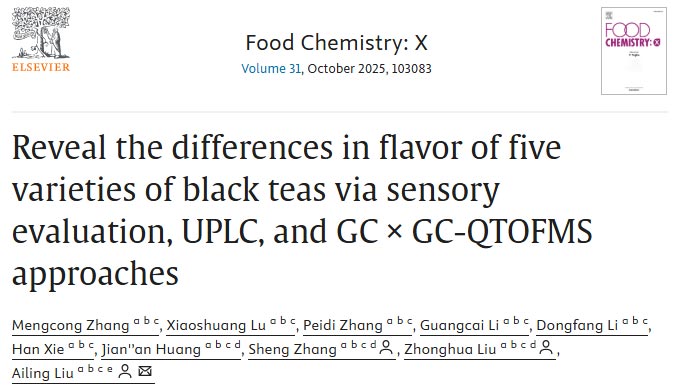
◆ Research Results
01. Medium-Quality Black Tea Samples
This study collected 18 black tea samples from various manufacturers, including Zunyi Black Tea (ZY), Keemun Black Tea (QM), Lapsang Souchong (ZS), Fengqing Dianhong (FQ), and Huangpu Black Tea (HP).
All black teas were made from the same tea plant variety and were produced with one bud and two leaves. Their price was around US$50 per kilogram (approximately 180 yuan per jin). For detailed product information, please see the table below.
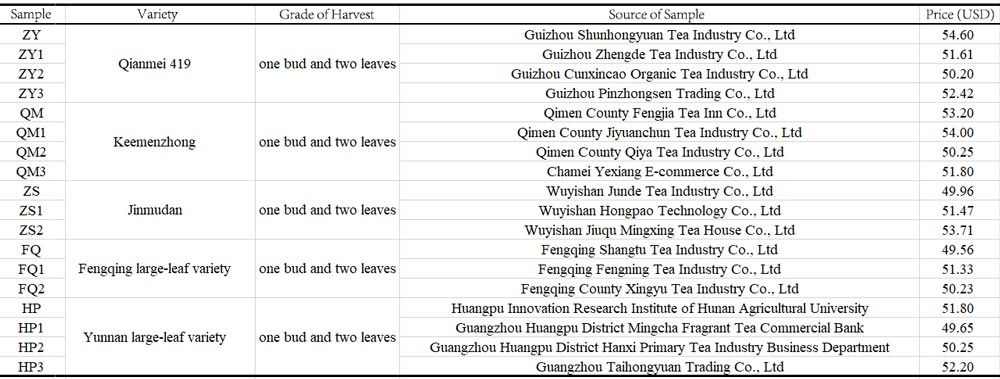
Selected Ancient Tree Tea Samples
The researchers compared the quality characteristics of five black teas in this price range through sensory evaluation and instrumental analysis.
02. Zunyi Black Tea: Sweetness and Refreshment
Zunyi Black Tea performed well overall, achieving a high average overall score. Its distinctive feature is its ingenious blend of sweetness and freshness, resulting in a mellow taste and pleasant aroma.

Dry teas of four Zunyi black tea varieties (ZY, ZY1, ZY2, and ZY3)
In terms of dry tea appearance, different samples have their own unique characteristics. Some exhibit a tight, fine, slightly golden tip, a uniform appearance, and a dark frosted finish; others, like ZY1, are thicker and more robust, with slightly golden tips.
Overall, the dry teas are characterized by a tight, fine tip, and a dark, glossy color, giving the first impression of high quality.

Tea soups of four Zunyi black tea varieties (ZY, ZY1, ZY2, and ZY3)
After brewing, the tea soups are generally bright red. This vibrant color enhances the tea's visual appeal.
In terms of aroma, Zunyi black tea is primarily sweet, with some samples exhibiting other aromatic elements. This is because Zunyi black tea contains significant concentrations of substances like linalool and phenylethyl alcohol, which impart a floral and fruity aroma. Combined with the unique β-ionone epoxide, this tea's sweetness is even more distinctive.
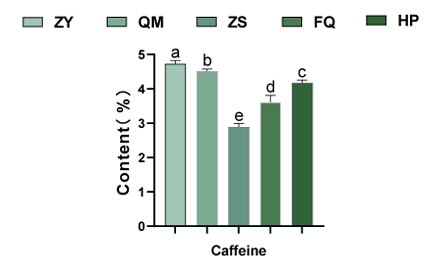
Zunyi black tea (ZY) has the highest caffeine content.
In terms of flavor, fullness is the primary characteristic of Zunyi black tea. While some samples, such as ZY1, may have a slight astringency, the overall richness remains distinct, resulting in a relatively balanced taste.
This is because Zunyi black tea has a significantly higher free amino acid content than other black teas, while also having the highest gallic acid and caffeine content among the five black teas. While this contributes to a slight astringency, it also adds depth to the flavor.

Leaf bases of four Zunyi black teas (ZY, ZY1, ZY2, and ZY3)
03. Keemun Black Tea: A symbol of high-pitched, long-lasting floral aroma
Keemen black tea is renowned for its high-pitched, long-lasting floral aroma and sweet, mellow flavor, making it a classic example of black tea.
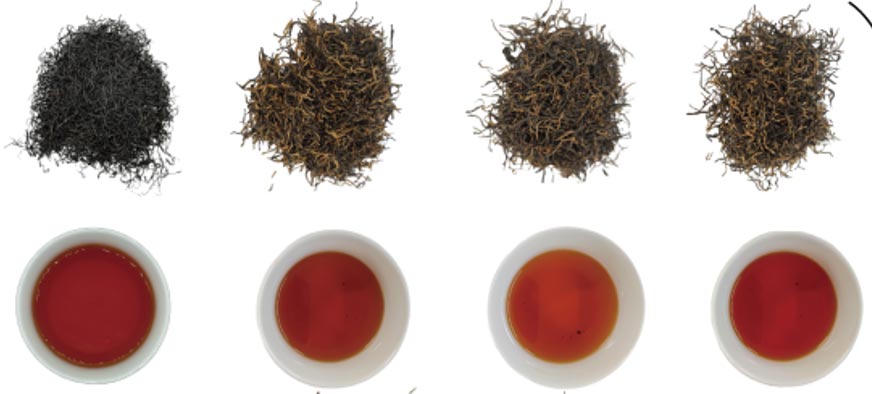
Dry tea and tea infusions of four Keemun black tea varieties (QM, QM1, QM2, and QM3)
Most dry teas have a firm, dense texture, with golden tips and a dark rime, demonstrating excellent appearance. This firm, dry appearance helps release the aroma and flavor during brewing.
The tea infusion is primarily red, with a high brightness. This vibrant color is a key visual highlight of Keemun black tea.
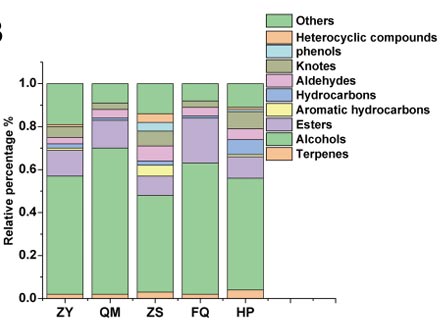
Keemen black tea has the highest content of volatile alcohols (green).
The aroma of Keemun black tea is one of its most distinctive features, offering a rich, long-lasting sweet, floral, and fruity aroma, sometimes with other notes. This rich, lingering aroma provides a continuous sense of pleasure throughout the tea sipping process.
The secret lies in its high content of linalool and phenylethyl alcohol, two key contributors to the "floral and fruity" aroma of black tea. Furthermore, the geraniol content in Keemun black tea far exceeds that of other varieties, amplifying the floral aroma. It also contains the unique ingredient α-cuberene, which imparts a herbal aroma that adds dimension to the overall flavor.
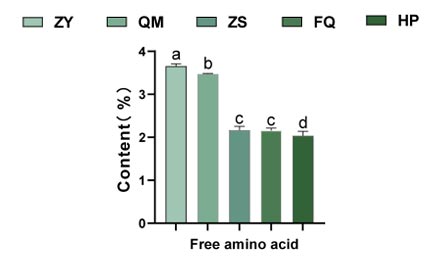
Keemen black tea (QM) has the second-highest free amino acid content.
In terms of taste, Keemun black tea is known for its sweet and mellow flavor. This sweet and mellow taste is appreciated by tea lovers, even those with discerning palates.
This is due to Keemun black tea's high free amino acid content, which results in a mellow tea flavor without a sharp bitterness.
The leaf base is mostly red, with some having a soft texture, though the uniformity varies slightly. These leaf characteristics are related to the tea variety and processing method.
04. Lapsang Souchong: A unique competitor with a smoky pine aroma
The Lapsang Souchong sample also performed well in the sensory evaluation. Its unique smoky pine aroma distinguishes it from other black teas, resulting in a high overall score.
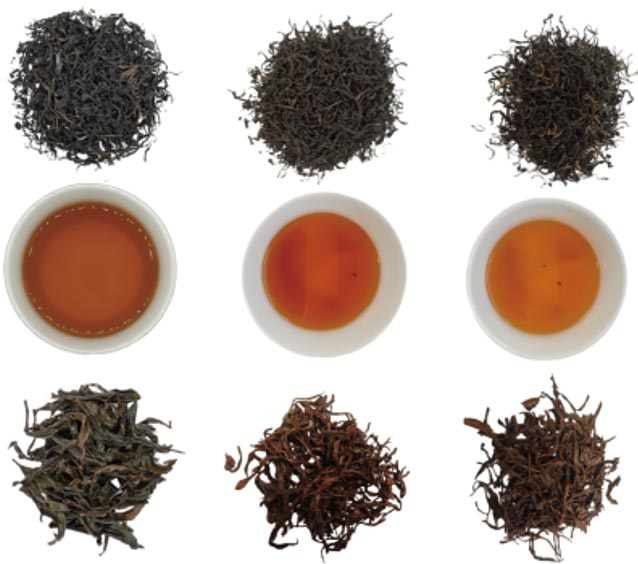
Sensory Characteristics of Three Lapsang Souchong Varieties (ZS, ZS1, and ZS2)
The dry tea is generally thick and firm, with a predominantly brownish-reddish-brown color. This rough appearance is related to the production process and tea variety of Lapsang Souchong.
The tea soup is often bright orange, giving off a warm feeling.
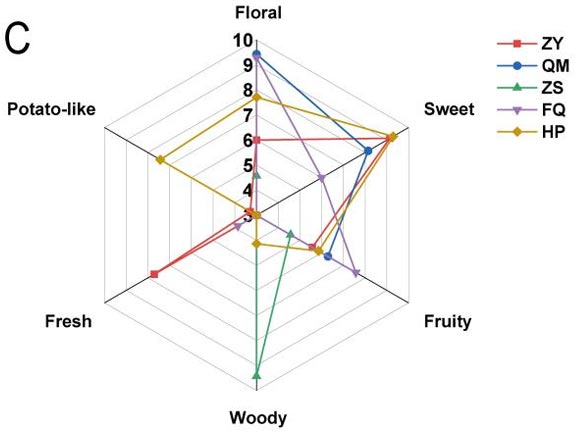
Lapsang Souchong's Prominent Woody Aroma
The most striking feature of Lapsang Souchong is its smoky, pine-like aroma. On the palate, Lapsang Souchong is primarily full-bodied, with some samples exhibiting a slight astringency. This richness, combined with a distinct smoky aroma, creates Lapsang Souchong's unique flavor.
This contrasting quality stems from the smoke-drying process. The high temperature and pine smoke not only accumulate the most volatile compounds, but also highlight the concentration of 4-ethyl-2-methoxyphenol, a key source of its smoky aroma.
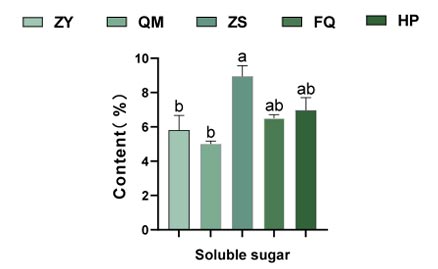
Lapsang Souchong (ZS) has the highest soluble sugar content.
Also, Lapsang Souchong has the highest soluble sugar content, which instantly maximizes its sweetness. Smoking accelerates oxidation, resulting in almost undetectable theaflavins. Combined with minimal caffeine and gallic acid content, the tea has minimal bitterness and a fresher, sweeter taste.
The tea leaves are often reddish-brown and relatively soft. These characteristics reflect the degree of fermentation and roasting during processing.
05. Fengqing Dianhong: A Balance of Floral and Fruity Aromas and Rich Flavor
The dry leaves of Fengqing Dianhong tea often exhibit a firm, dense, and robust appearance, with a brownish-reddish-brown color. This robust appearance reflects the richness of the tea leaves.
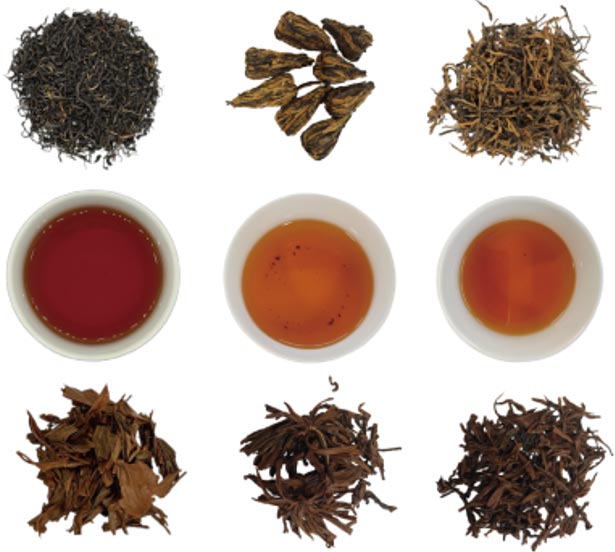
Sensory Characteristics of Three Fengqing Dianhong Teas (FQ, FQ1, and FQ2)
The tea soup is primarily red, with a high brightness, highlighting the vitality of Fengqing Dianhong tea. Fengqing Dianhong tea offers a pure, long-lasting aroma, while some samples also possess sweet or floral notes.
The unique ingredient, borneol, imparts a subtle woody aroma, while the addition of heptanal enhances the floral and fruity notes. The high concentration of linalool adds depth and richness to the overall aroma, giving Fengqing Dianhong tea a depth and layered flavor.
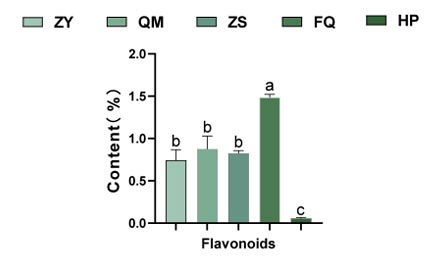
Fengqing Dianhong (FQ) tea has the highest flavonoid content.
The taste is characterized by a richness, with some samples exhibiting a slightly astringent taste. Because Dianhong tea has the highest concentration of flavonoids, these compounds enhance the astringency of black tea. Furthermore, its high catechin content contributes to a richer, more robust flavor.
06. Huangpu Black Tea: A versatile tea with a predominantly sweet aroma
Huangpu Black Tea has a firm, dark appearance. Upon brewing, its aroma is primarily sweet, with hints of floral, fruity, and a subtle sweet potato aroma.
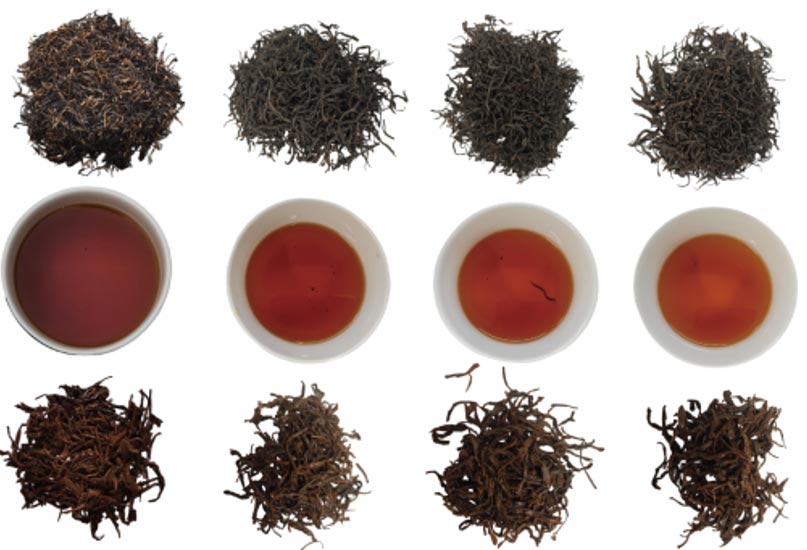
Sensory Characteristics of Four Huangpu Black Teas (HP, HP1, HP2, HP3)
In terms of taste, the most surprising aspect of Huangpu Black Tea was its smoothness.
This is due to two key components: first, the highest content of theanine, which enhances freshness and counteracts bitterness; second, the lowest content of flavonoids, which directly reduce astringency.
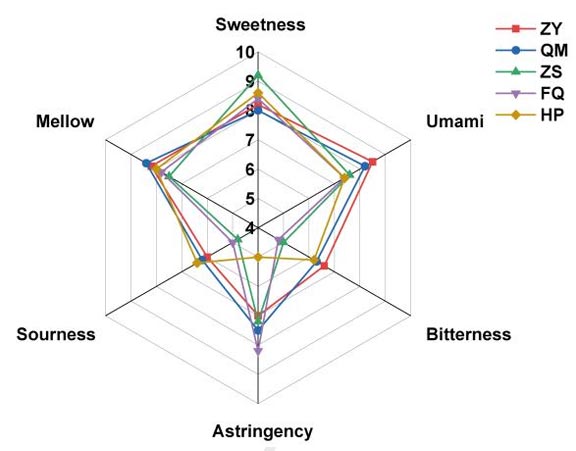
Huangpu Black Tea (HP) has the lowest astringency.
In terms of aroma, Huangpu Black Tea exhibits prominent levels of linalool oxide I and (E)-furanyl linalool oxide. These compounds impart sweet and milky aromas, while the woody notes of trans-calanene enhance the sweetness, making it less monotonous.
• Conclusion
Finally, the researchers constructed a "Black Tea Aroma Wheel" based on 51 active aroma compounds, categorizing aroma into six categories: floral, fruity, and sweet. This allows for a more intuitive understanding of the aroma characteristics of different black teas.

%20--%3e%3c!DOCTYPE%20svg%20PUBLIC%20'-//W3C//DTD%20SVG%201.1//EN'%20'http://www.w3.org/Graphics/SVG/1.1/DTD/svg11.dtd'%3e%3csvg%20version='1.1'%20id='图层_1'%20xmlns='http://www.w3.org/2000/svg'%20xmlns:xlink='http://www.w3.org/1999/xlink'%20x='0px'%20y='0px'%20width='256px'%20height='256px'%20viewBox='0%200%20256%20256'%20enable-background='new%200%200%20256%20256'%20xml:space='preserve'%3e%3cpath%20fill='%23FFFFFF'%20d='M194.597,24.009h35.292l-77.094,88.082l90.697,119.881h-71.021l-55.607-72.668L53.229,232.01H17.92%20l82.469-94.227L13.349,24.009h72.813l50.286,66.45l58.148-66.469V24.009z%20M182.217,210.889h19.566L75.538,44.014H54.583%20L182.217,210.889z'/%3e%3c/svg%3e)



